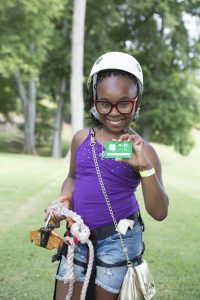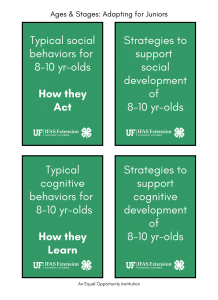 In a recent study, one of the top things 4-H volunteers are looking for are ideas for adapting activities to different age groups (Kent, 2022). Florida 4-H offers experiences for four different age groups: Cloverbuds (ages 5-7), Juniors (ages 8-10), Intermediates (ages 11-13), and Seniors (ages 14-18). 4-H encourages family involvement and engagement, and volunteers often find themselves working with a variety of age groups. That means that often, volunteers find themselves adapting activities on the fly to meet the needs of each youth. That might seem a little overwhelming, but this post series gives practical tips and strategies to make it less daunting. This week’s post is focused on adapting activities for junior age 4-H members. In case you missed it, check out last week’s post on adapting activities for Cloverbuds. This post also includes free downloadable flashcards as a handy reference tool!
In a recent study, one of the top things 4-H volunteers are looking for are ideas for adapting activities to different age groups (Kent, 2022). Florida 4-H offers experiences for four different age groups: Cloverbuds (ages 5-7), Juniors (ages 8-10), Intermediates (ages 11-13), and Seniors (ages 14-18). 4-H encourages family involvement and engagement, and volunteers often find themselves working with a variety of age groups. That means that often, volunteers find themselves adapting activities on the fly to meet the needs of each youth. That might seem a little overwhelming, but this post series gives practical tips and strategies to make it less daunting. This week’s post is focused on adapting activities for junior age 4-H members. In case you missed it, check out last week’s post on adapting activities for Cloverbuds. This post also includes free downloadable flashcards as a handy reference tool!
What are “Ages & Stages” and Why Does it Matter?
“Ages & stages” is a phrase commonly used in youth development that refers to the physical, social, emotional, and cognitive development of a young person. These categories of development are based on the work of researchers such as Piaget and Erickson. Understanding these categories help 4-H volunteers and professionals provide opportunities for youth to thrive through social and emotional learning and is a key part of the 4-H Thrive Model (Arnold & Gagnon, 2020). There are several benefits of selecting (or adapting) age-appropriate activities for youth:
- First, it makes learning fun! Fun is important; boring is bad.
- Youth are more engaged. When activities are not too challenging or too easy, they are in what’s called the “zone of proximal development,” or ZPD (Vygotsky, 1978). This is key to helping learners master new skills. ZPD refers to skills or knowledge that are too difficult for a youth to master on their own, but possible to master with guidance from a more knowledgeable person- like their 4-H volunteer!
- Youth can build on past learning experiences and create future opportunities to grow.
- When learning is fun and youth are engaged, youth stay involved in 4-H!
How to Use “Ages & Stages” to help Juniors Thrive
Social Development of 8-10 year-olds (how they act)
Youth who are 8-10 years old are learning how to be competent at activities valued by adults or their peers. When they struggle with competence, it is easy for them to feel inferior. It is best not to compare one youth to another. Instead, focus on how youth improve over time. Use the “oreo” method to compliment them on something they do well, then give them some constructive feedback, followed by another compliment.
| Typical social behaviors for 8-10-year-olds include: | Strategies for supporting social development of 8-10-year-olds: |
|
|
Cognitive Development of 8-10-year-olds (how they think)
Youth who are 8-10 years old are beginning to learn how to think more abstractly. They can now think in terms of cause and effect and understand the logic behind concrete events. They are also beginning to be able to “see” mental representations of ideas or concepts, such as the water cycle.
| Typical learning behaviors for 8-10-year-olds include: | Strategies for Supporting Cognitive Development of 8-10-year-olds: |
|
|
Examples of Ages & Stages Applied for Juniors
Throughout this series, we have been using examples from each of the three pillar programs in 4-H: Citizenship & Leadership, Science, and Healthy Living. These examples are meant to help parents and volunteers see how an activity can be adapted for each of the different age groups. For examples for other age groups, check out our previous post about Cloverbuds.
- Citizenship & Leadership: For citizenship & leadership, we have been using the example of a 4-H club business meeting. Eight to 10-year-olds can follow the club meeting script to begin to learn about the order of a business meeting. You can write a different role on popsicle sticks, then ask youth to draw a role at the beginning of each meeting. Y This way, they begin to learn about leadership roles and the business meeting model without the pressure of needing to know what to say. Eight to 10-year-olds will also want to be involved in committee work, led by an older, more experienced youth or with the help of a parent volunteer. During committee meetings, allow youth to plan parts of club events such as celebrations, fundraisers, or service projects.
- Science: For science, we have been using the 4-H entomology project as an example. Entomology is the study of insects. Eight to 10-year-olds can catch and begin to identify insects using a simple key. They may also want to pin and display their insects at their county or regional fair. They could also team up with a friend and give an illustrated talk or demonstration about what they have learned about insects for their club or county events.
- Healthy Living: For Healthy Living, we have been using the 4-H personal wellness project as an example. This project area helps youth learn about nutrition, physical fitness, and mental health. For juniors, this could be an opportunity for them to explore other cultures through food. Ask different youth to share what their family’s favorite meals are. This is a great way for them to cultivate learning beyond their home to include their neighborhood and community.
Using “Ages & Stages” approach with youth reinforces the Essential Elements of 4-H: Belonging, Mastery, Independence, and Generosity. This is also key to helping youth thrive. However, each individual youth grows at their own pace and might not completely meet the general tendencies listed above. As volunteers and 4-H professionals, it is important to observe youth and meet them where they are physically sociality, and intellectually. Adapting activities on the fly gets easier with practice- download this set of flashcards for a quick reference guide. You can print them, cut them out, and punch them to fit on a lanyard as a handy teaching aid. Your local 4-H agent is always available to help and provide additional resources if you have questions.
References:
Arnold, M. E. & Gagnon, R. J. (2020). Positive youth development theory in practice: An update on the 4-H Thriving Model. Journal of Youth Development, 15(6), 1-23.
Erikson, E. H. (1963). Childhood and Society (2nd Ed.). New York: Norton.
Kent, H.C. (2022). Informal learning to support volunteer performance. [Unpublished doctoral dissertation]. Florida State University.
Lee, F. and Go, C. (2002). Developmental stages. UC ANR 4-H Youth Development Program.
Piaget, J. (1971). The theory of stages in cognitive development. In D. R. Green, M. P. Ford, & G. B. Flamer, Measurement and Piaget. McGraw-Hill.
Pleskac, S. (2000). Educational design and delivery: Use of age-appropriate activities. VRKC fact sheet.
Vygotsky, L. S. (1978). Mind in society: The development of higher psychological processes. Cambridge, MA: Harvard University Press.
- Meet our Summer Intern- Andy Franklin! - June 13, 2025
- Blue Ribbon Baked Goods - September 23, 2024
- Blue Ribbon Photos and Posters - September 21, 2024

